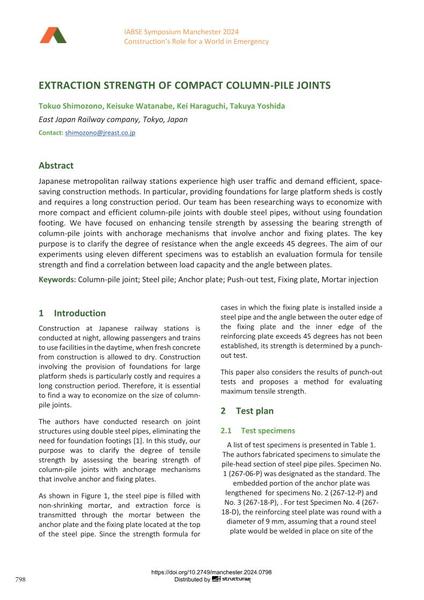Extraction Strength of Compact Column-Pile Joints

|
|
|||||||||||
Bibliografische Angaben
| Autor(en): |
Tokuo Shimozono
(East Japan Railway company, Tokyo, Japan)
Keisuke Watanabe (East Japan Railway company, Tokyo, Japan) Kei Haraguchi (East Japan Railway company, Tokyo, Japan) Takuya Yoshida (East Japan Railway company, Tokyo, Japan) |
||||
|---|---|---|---|---|---|
| Medium: | Tagungsbeitrag | ||||
| Sprache(n): | Englisch | ||||
| Tagung: | IABSE Symposium: Construction’s Role for a World in Emergency, Manchester, United Kingdom, 10-14 April 2024 | ||||
| Veröffentlicht in: | IABSE Symposium Manchester 2024 | ||||
|
|||||
| Seite(n): | 798-805 | ||||
| Anzahl der Seiten (im PDF): | 8 | ||||
| DOI: | 10.2749/manchester.2024.0798 | ||||
| Abstrakt: |
Japanese metropolitan railway stations experience high user traffic and demand efficient, space- saving construction methods. In particular, providing foundations for large platform sheds is costly and requires a long construction period. Our team has been researching ways to economize with more compact and efficient column-pile joints with double steel pipes, without using foundation footing. We have focused on enhancing tensile strength by assessing the bearing strength of column-pile joints with anchorage mechanisms that involve anchor and fixing plates. The key purpose is to clarify the degree of resistance when the angle exceeds 45 degrees. The aim of our experiments using eleven different specimens was to establish an evaluation formula for tensile strength and find a correlation between load capacity and the angle between plates. |
||||
| Stichwörter: |
Push-Out Versuch Ankerplatte
|
||||
